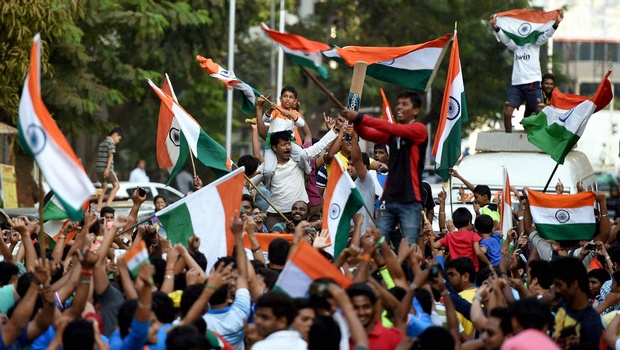Every few months, the advertising on TV channels seems to go into an insane spiral of jingoistic patriotism. This has nothing to do with the nation, however, but rather with Cricket!
Yes, as the various Indian sports channels, soft-drink makers, phone manufacturers and a hundred other brands remind us (especially when a World Cup comes around), India loves cricket.
To try and understand why a British game has become so closely identified with India, we have to look a little into the history of the game, as well as the social changes that shaped its growth.
It is universally acknowledged that while the game may or may not have originated in France, it took root in a broad-based way in England. There is talk of Cricket being played in some form or the other during the Tudor rule, and by the reign of George III, cricket was the most popular sport among the gentry of that country. The peasants by and large preferred football.
As the British expanded their empire throughout the world, they spread their sports as well. No country was as integral to the Empire as India, and far more British younger sons came here to earn their fortunes than anywhere else. While the common soldiers played football and hockey, the officers of the army and the high-level bureaucrats played cricket. Since you need a lot of people to be fielders, they taught the ‘natives’ the game, and within a few decades, Indians had formed their own domestic cricket leagues, the Quadrangulars and Pentangulars. In a way the reason for Cricket’s popularity is the same as that for the popularity of the English language – in a country divided by religious practices, festivals and geographical layout, the British presence meant that Cricket was the only sport played in the same form in Simla as it was in Madras.
By the early twentieth century, Indian cricketers had begun to make a mark in the world. Relatives of royal families like Ranjitsinghji and the Nawab of Pataudi made names for themselves playing English county cricket and even got picked to play for England. It was inevitable that India would soon be given a chance to play as an international team for itself. The milestones are well-documented; first match, first win, first series win, and so on. But the emergence of Cricket as a sport commanding the kind of fanatic following it does today traces to the famous Indian victory in the 1983 World Cup, followed by the growth of the Television industry in India.
The rise of Indian cricket co-incided with a decline in Indian hockey. From being the best team in the world, the hockey team was reduced to barely qualifying for the Olympics. At the same time, cricket was on the ascendant, with Indian players commonly counted among the world’s best, even if the team as a whole was not. Sponsor money poured in, and both hype and expectations reached a fever pitch.
In the late nineties and 2000’s India actually went through a phase of being considered a serious challenger to the Australian domination of the game. The legend of the ‘Fab Four’ batsmen meant that Indians had more heroes than ever to look up to. At the same time, players like MS Dhoni and Sehwag who were not from mainstream cricketing centres spread the sport to non-metro locations.
The profile of the Indian cricket fan was changing – as the urban elites began to follow more international sports, the masses took to cricket in a big way. After all, cricket lends itself to two things very easily –
1. Making heroes out of Individuals rather than the team: In a country where individual achievement has always got more attention than collective effort, the fact that Cricket allows players to rise above their team limitations (as opposed to hockey or football, where a player can only be as good as the rest of the team allows him to be) means that it will always inspire a greater following.
2. An ad-friendly format. No sport has as many breaks as Cricket. Between overs, when a wicket falls, between innings…cricket is tailor-made for marketing. And then you can have logos on the field, side-lines, scoreboard.
In short, the advertising industry and the fans feed each other, a cycle of affirmation of each other, the money poured into the sport and the passion it whips up.
As more Indians join the mainstream, this type of frenzy will no doubt continue to build for the near future. The only variable remains the performance of the Indian cricket team – but then, the IPL could well address that as well, by de-linking cricket fanaticism from national team’s performance.
Until then, however, let’s content ourselves with channelling the cricket fanaticism into a patriotic fervour and back India at the World T20!































